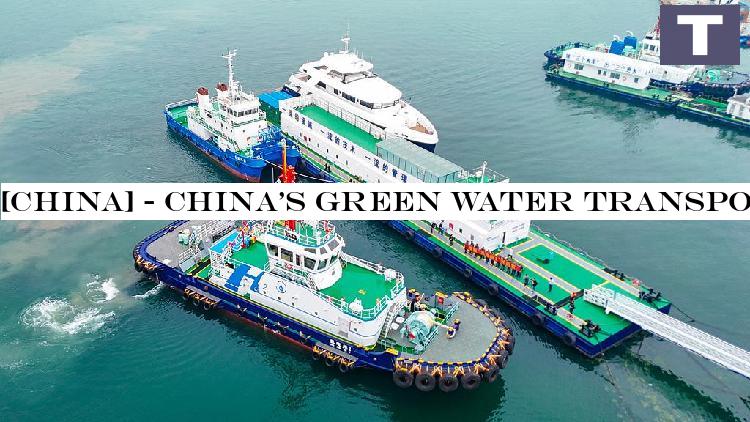INSUBCONTINENT EXCLUSIVE:
Assisted by its double carbon objective to peak carbon emissions before 2030 and attain carbon neutrality by 2060, China is actively
developing a green, low-carbon and effective water transport system as a vital part of promoting its green advancement strategy.At a press
conference on Friday, the Ministry of Transport reported considerable improvements in the adoption of greener fuels in inland water
transport.The nation now has more than 1,000 new energy- and tidy energy-powered vessels operating nationwide.Vice Transport Minister Fu
Xuyin specified that, as of completion of 2024, the nation had over 600 melted gas (LNG) vessels and 485 battery-powered electric vessels,
as well as 4 methanol fuel-powered ships and two hydrogen fuel cell-powered ships in service.Yang Huaxiong, director general of the Water
Transport Bureau of the Ministry of Transport, highlighted the significance of maritime shipping to Chinas position as the worlds biggest
trading country, noting that a strong maritime sector is crucial for developing a powerful ocean and trade nation.A notable achievement in
Chinas green maritime progress has been the recent delivery of COSCO SHIPPING Yangpu, the countrys very first domestically built 16,000
twenty-foot comparable system (TEU) methanol dual-fuel container ship
The 366-meter-long vessel includes an ultra-large 11,000-cubic-meter methanol tank, enabling a one-way trip from the Far East to the U.S
East Coast without refueling
It is equipped with the first homegrown methanol dual-fuel primary engine, a dual-fuel marine boiler, and the countrys very first methanol
generator system used on a container ship
The dual-fuel system allows smooth switching between fuel types depending upon specific route needs.The vessel can cut carbon dioxide
emissions by about 120,000 tonnes annually –-- comparable to the carbon sequestration of planting 6.7 million trees.On May 15, Chinas
largest photovoltaic (PV) and LNG dual-fuel cars and truck carrier, Yuan Hai Kou, set sail on its first trip from Nansha, south Chinas
Guangzhou Province.The vessel boasts several green and intelligent technologies to ensure low-carbon operation throughout the entire voyage
A sophisticated LNG dual-fuel primary engine, it is geared up with a 302.8 kW PV system that generates 410,000 kWh each year, saving 111
tonnes of fuel and cutting carbon emissions by 345.9 tonnes
It is likewise fitted with a medium-voltage coast power user interface, which utilizes 100 percent shore power throughout port berthing,
decreasing carbon dioxide by about 21 tonnes per day.Green, wise portsChina is advancing quickly in the construction and improvement of
automation and intelligence in ports, stated the ministry
Presently, the nation has developed 23 automated container terminals and 29 automated dry bulk terminals
Innovative technologies such as 5G autonomous container trucks and train systems, remote-controlled automated lawn cranes, and wise gate
systems have actually been extensively adopted.Qingdao Port in east Chinas Shandong Province is a global leader in automated and green
development, being the first hydrogen-powered 5G wise terminal in Asia.It focuses on green, low-carbon growth by incorporating renewable
resource with a PV system that creates over 1.7 million kWh yearly, cutting carbon emissions by 1,500 tonnes
The port has likewise originated making use of hydrogen-powered equipment and developed Chinas first hydrogen-powered rail crane
Additionally, the ports self-developed hydrogen fuel cell and lithium battery energy management systems optimize energy usage, helping
reduce carbon emissions by about 3.5 kgs and sulfur dioxide emissions by 0.11 kg per TEU.Yantian Port in Shenzhen, south Chinas Guangdong
Province, blazes a trail with coast power systems, lowering emissions by approximately 98 percent by supplying ships with electrical power
from the shore instead of utilizing diesel.In 2016, with the help of the regional power supply department, Yantian Port started using six
intelligent shore power systems, with the coast power coverage rate for berths going beyond 95 percent
By 2024, the coast power system at the port had supplied nearly 25 million kWh of electrical energy to ships, minimizing ship carbon
emissions by around 19,000 tonnes.Across the Guangdong-Hong Kong-Macau Greater Bay Area, ports like Mawan Smart Port and Nansha Port are
integrating AI, 5G and new energy-powered machinery to boost performance and reduce emissions.China is deeply advancing structural carbon
decrease in the maritime sector, accelerating the application of new energy, and improving pollution control for ports and vessels to build
a clean, low-carbon maritime energy system, stated Yang
He included that the nation motivates global cooperation to develop green shipping corridors, promoting a global transition to low-carbon
global shipping.Additionally, China is strongly promoting the integration of new innovations such as AI, big data and blockchain to improve
data connection and improve the efficiency, quality and cost-effectiveness of maritime services, he said.

